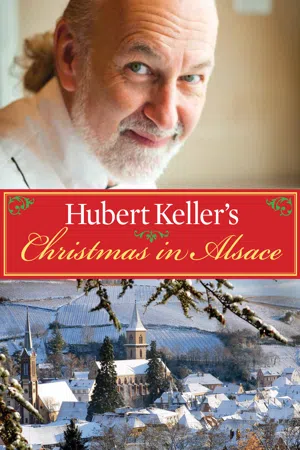
This is a test
- 30 pages
- English
- ePUB (mobile friendly)
- Available on iOS & Android
eBook - ePub
Hubert Keller's Christmas in Alsace
Book details
Book preview
Table of contents
Citations
About This Book
A James Beard award winning celebrity chef shares his family Christmas traditions and twenty of his favorite recipes from his boyhood home of Alsace, France. From multitalented Hubert Keller, chef, restauranteur and Frenchman, a cookbook commemorating the Christmas traditions he celebrated with his family in his childhood home of Alsace, France. Filled with personal reminiscences, beloved recipes and photos from chef Keller's life, this cookbook is a tribute to the culture and food of the Alsatian region.
Frequently asked questions
At the moment all of our mobile-responsive ePub books are available to download via the app. Most of our PDFs are also available to download and we're working on making the final remaining ones downloadable now. Learn more here.
Both plans give you full access to the library and all of Perlego’s features. The only differences are the price and subscription period: With the annual plan you’ll save around 30% compared to 12 months on the monthly plan.
We are an online textbook subscription service, where you can get access to an entire online library for less than the price of a single book per month. With over 1 million books across 1000+ topics, we’ve got you covered! Learn more here.
Look out for the read-aloud symbol on your next book to see if you can listen to it. The read-aloud tool reads text aloud for you, highlighting the text as it is being read. You can pause it, speed it up and slow it down. Learn more here.
Yes, you can access Hubert Keller's Christmas in Alsace by Hubert Keller in PDF and/or ePUB format, as well as other popular books in Art & Culinary Arts. We have over one million books available in our catalogue for you to explore.
Information
Topic
ArtSubtopic
Culinary Arts
During the holiday fair in Ribeauvillé. Do you see the castle outlined against the sky in the background?

“Maybe Alsatians celebrate so extravagantly over the holidays because of the long, dark winters.”
From left: Homemade head cheese by Lili Baltenweck with foie gras buns made by Rémy Schaal. Ribeauvillé under snow.
WIHNACHTE CHEZ CHANTAL AND HUBERT
WIHNACHTE MEANS “HOLY NIGHT” in the Alsace dialect. The holidays are such a big deal in Alsace that Chantal and I always make a big deal of them at home, too. Maybe Alsatians celebrate so extravagantly because of the long, dark winters. Or maybe it is because our holiday traditions date back to the sixteenth century. One of the earliest records of Christmas trees is from Sélestat, a tiny town just a few kilometers from Ribeauvillé. Just as Ribeauvillé has its Medieval Christmas fair, Sélestat holds a fair to celebrate the Christmas tree. A huge forest of trees is created in the town for the children to wander through. It was not until the 1700s that Marie Leszczyńska, wife of Henri XV, introduced Christmas trees to the court, setting them up in the palace at Versailles. The trees were decorated with paper flowers, dried roses, cookies, and dried apples.
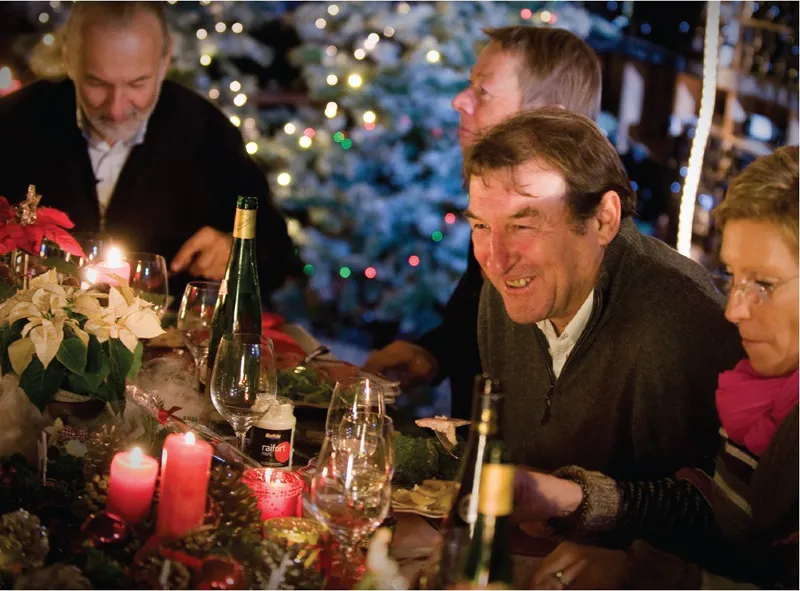
Me, Lili Baltenweck, Dany Haas, and his wife, Michele, at our holiday party in Alsace.
Everyone at home makes the most of the holidays. We shop the Christmas street fairs while drinking Vin Chaud and eating Pain d’Épices baked in the shape of St. Nicholas. The breads have an antique image of St. Nicholas pasted on them with sugar glaze. Children and adults alike peel off the picture, eat the bread, and hang the souvenir on their tree at home. And we buy or bake all the traditional holiday treats: Petits Bonhommes, brioche baked in the shape of boys with raisin eyes and buttons; the pain d’épices shaped or cut into squares and sometimes baked as loaves; the Christmas Star baked in traditional, old-fashioned star-shaped molds; and Anise Cookies. Kugelhopf and stollen are always included as well. The treats are set out in every household as buffets and offered to visitors—adults and children—throughout the day.
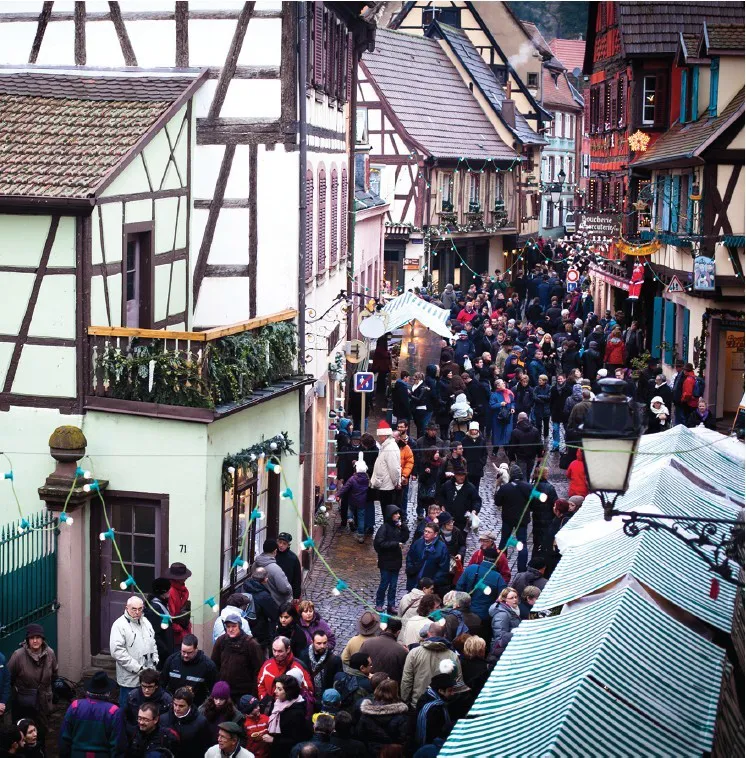
Dusk during the December holiday fair.
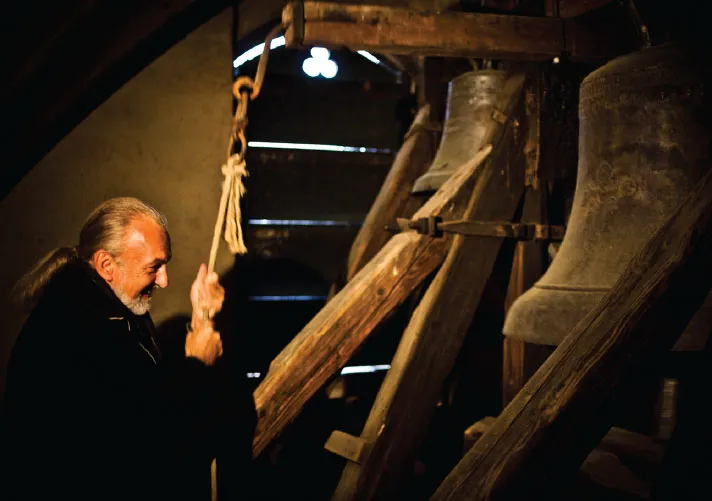
I was so excited when Ribeauvillé’s mayor took me up into the town’s bell tower and let me pull the rope to ring the bell.
I have not included a recipe here for stollen, which I think is more German than Alsatian in origin. It is basically a brioche dough with dried fruit, nuts, candied orange zest, and marzipan folded in. You can easily make a similar bread by using brioche dough and kneading in a half pound or so of fruits and nuts.
Early in December Chantal begins decorating our house—lining the front steps with poinsettias and hanging red bows all over. We set up a tree, and every year it has a new look. Usually Chantal chooses a color theme and then goes from there. When it was white, the tree was covered in white feathers. When it was blue, the lights and balls were blue and there were little mirrors to create reflections. Like everyone else, we have an ornament collection. Many are gifts from friends and Fleur de Lys guests who often choose ornaments in the shapes of fleurs-de-lys, burgers, and boxes of fries. By the week before Christmas, Chantal has set the table. She will have collected all sorts of decorations to fill out her ideas. For a red-and-white-themed year she set up a tray of champagne flutes and put a candy cane in each one to act as a stirrer for her champagne cocktails. And she bought solid chocolate Santas in dark and white chocolate. These were the place cards—she glued the name of each guest underneath the Santas. Finding your seat became a game of hide-and-seek.

For my first cookbook, my mom and dad sent me the recipe for Schnetzwecka, a traditional Christmas bread.
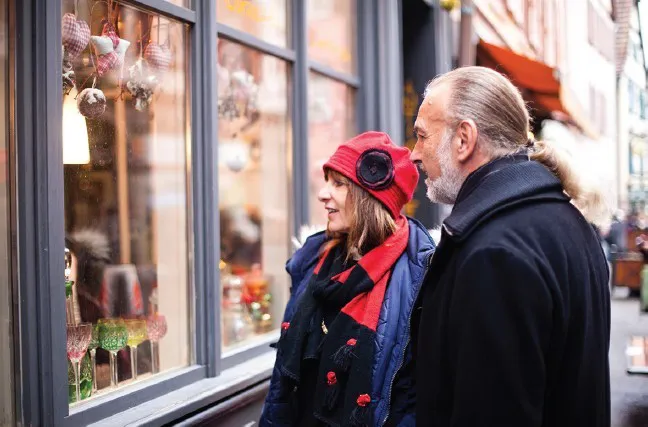
Chantal and me admiring Christmas window displays.
Every year, for many years, the same group of friends has gathered at our house for Christmas dinner. Everyone brings a dish (when we first moved to San Francisco and lived in a small apartment, guests had to bring their own chairs) to round out the menu. And Chantal and I do the appetizers and the plat principal, which is usually from Fleur de Lys. (The restaurant has a new, special menu each Christmas Eve and closes Christmas Day.) It could be roasted lamb chops, venison, baeckeoffe / laundry day stew made with lots of black truffles, or Beef Wellington. To begin, we always have oysters and smoked salmon, which are traditional for the holidays in Alsace, too. If we were in Alsace, we would have foie gras as well. It is made throughout the region and comes to market especially for the holidays.
Petits Bonhommes
ONE OF THE MANY TREATS my brother and I looked forward to during the Christmas holidays was having a freshly baked petit bonhomme for breakfast or for an afternoon snack. The breads seemed to have a best friend, too: hot chocolate. Still today shop windows display the petits bonhommes in sizes ranging from seven or eight inches to several feet high. Some families buy a large bread to put in the middle of the holiday breakfast table. My father made his petits bonhommes from brioche but tells me they can also be made from the kugelhopf dough.
Makes about 10 individual petits bonhommes
1 recipe Brioche Bretzel dough, through first rise (recipe follows)
2 egg yolks
Raisins, nuts, dragées, or other such decorations
½ cup (2 ounces) powdered sugar (optional)
Punch the dough down and turn it out onto a lightly floured work surface. Cut the dough into 10 evenly sized pieces (about 3 ounces each) and roll each into a ball. Cover with a kitchen towel and let them rest for about 15 minutes.
Line 2 baking sheets with nonstick baking mats or parchment paper. Preheat the oven to 400°F.
To shape the petits bonhommes: Make sure your figures are very distinct; otherwise the shape will be lost in the oven as the breads rise. Use very little to no flour on the work surface. You need the dough to stick slightly to the countertop. Roll each ball into a log about 6 inches long. To form the head, about 1 to 1½ inches in from one end, press down with the edge of your hand. Roll your hand back and forth. A neck will form and the head above it. Taper the body so it’s wider at the shoulders and narrower toward the feet. Pat the body down to flatten it. With a sharp knife or with sharp scissors, make a single cut to form the legs and pull them apart. (Dipping the blades in water helps them cut more cleanly.) Make 2 diagonal cuts beginning at about the waist and angling in and up to below the shoulders. Pull the arms out. After that you can play, perhaps making a hat or muffler from scraps. Transfer the breads to the baking sheets, cover with kitchen towels, and let them rise for about 30 minutes.
In a small bowl, whisk the egg yolks with 1 teaspoon of water. With a pastry brush, brush the breads with the egg wash. Press the raisins or other decorations firmly into the breads to make eyes, noses, buttons, and other details as your imagination prompts. Ba...
Table of contents
- Cover
- Hubert Keller's Christmas in Alsace
- Souvenirs
- Feedback
- Copyright